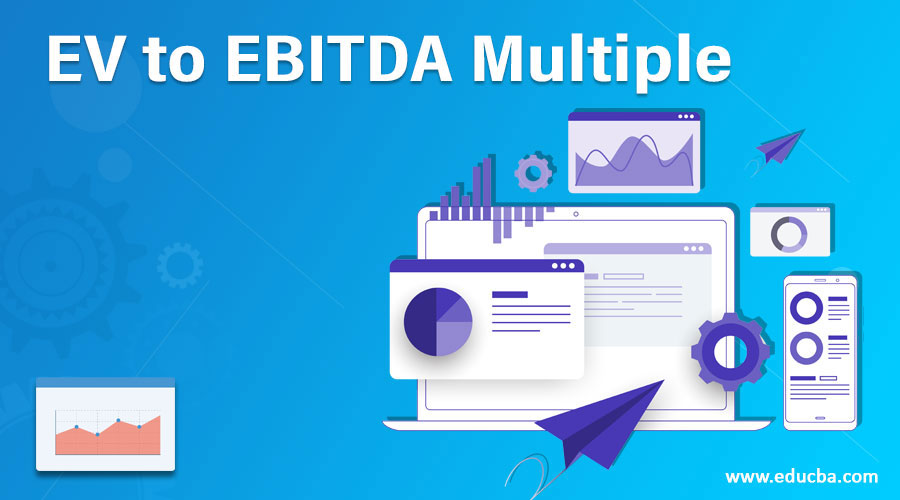Updated July 14, 2023
What is EV to EBITDA Multiple
The following articles provide an outline of EV to EBITDA Multiple. As the name suggests, enterprise value measures the company’s total value. Enterprise value is determined by considering the debt and any liquid cash in the company’s balance sheet. Enterprise valuation helps to understand whether the company can take any business. Enterprise value helps investors to decide on their investment plans.
The full form of EBITDA is Earning Before Interest, Taxes, Depreciation, and Amortization. The EBITDA calculates to evaluate the company’s financial strength before clearing the dues of the company. Investors can decide by checking the EBITDA value because it is free from any financial and taxation decisions that manipulate the earnings to a greater extent.
Formula
The Enterprise Value to EBITDA multiple calculates by dividing the Enterprise value by EBITDA.
How to Calculate EV to EBITDA Multiple?
The Enterprise multiple calculates by calculating the enterprise value with the help of the following formula, and then the EBITDA is calculated. Then Enterprise value divides by the EBITDA value to get the Enterprise Multiple.
- EBITDA = Earnings before Interest, Taxes, Depreciation, and Amortization.
Uses and Importance
- It helps the investors planning to invest in the company since it provides the company’s true financial condition, and thus the investment decision is easy to make.
- The Enterprise Value to EBITDA is multiple and doesn’t consider the debts, thus showing the exact outcome.
- The calculation of the EV to EBITDA multiple also acts as a valuation tool, and thus the benefit can be derived.
- In calculating the EV to EBITDA multiple, the EBITDA is calculated by considering the earnings before interest, taxes, depreciation, and amortization; thus, it helps the investors understand the company’s financial status before paying the debts.
- Expert analysts have proved that the EV to EBITDA Multiple is better than the Price to earnings ratio. The Price to earnings ratio gives the equity multiple, whereas the EV to EBITDA Multiple helps to find out the entire valuation of the company concerning market capitalization.
- It helps to determine and compare the valuation of the company.
- It also helps to make the investors aware of the company’s prospects in terms of revenue.
- It can help the company improve because the other company in the same domain also releases the EV to EBITDA multiple of their company. Thus, they can easily improvise themselves.
- It plays a vital role for the investors to decide upon the investment.
- The EV to EBITDA multiple comprises market capitalization, minority interest, preference shares, and debts, with the deduction of cash from the enterprise value. Thus it is an ideal method to do the comparison.
Advantages of EV to EBITDA Multiple
- It helps the investors make decisions because it provides a true picture of the company regarding finance.
- It doesn’t consider the debts and the other incidental expenses related to the company, giving a true picture of the company.
- Investors compare the company’s valuation with other companies using the EV to EBITDA multiple to determine if it is overvalued.
- Investors use this EV to EBITDA multiple to evaluate whether the company is overvalued compared to the other company in the industry.
- It also provides a deep understanding of the earnings, other than its debts and other incidental costs.
- It helps to improve the company’s condition because it provides the exact condition of the company.
- It is better than the Price-earnings Ratio since the price-earnings ratio only focuses on the equity, whereas the EV to EBITDA multiple focuses on the earnings.
Drawbacks of EV to EBITDA Multiple
- The EV to EBITDA multiple has a few drawbacks; The EV to EBITDA multiple does not consider the incidental cost, making it impractical.
- It can show incorrect values to the investors because the incidental cost is huge; therefore, it is not relevant sometimes for the investors to include the EV to EBITDA multiple in their decision-making.
- It is also related to past trends, and thus the effect of the valuation will not be so effective.
- Sometimes it can mislead investors.
- The debts and the incidental costs differ for different companies; therefore, the comparison, usually done in the industry, can mislead investors.
- Considering this method solely for investment purposes is not feasible because it does not consider numerous elements.
Conclusion
It is calculated by dividing the Enterprise value by the EBITDA. The enterprise value consists of market capitalization, all the minority interest, preference shares, etc., which will form the company’s value, and then the value divide by the EBITDA to get the Enterprise Value to EBITDA multiple. This multiple is very helpful for the investors to decide on the investment in the company whose Enterprise value they are considering. The EV to EBITDA multiple has a drawback; it does not consider the incidental cost in its calculation, which is practically impossible. The earnings should be shown and considered after paying off all the debts. Also, it has been seen that some big companies have great incidental costs. Thus, in that case, if the decision to invest will be made entirely on the Enterprise Value to EBITDA multiple, then it can be very risky.
Recommended Articles
This is a guide to EV to EBITDA Multiple. Here we discuss the introduction, calculating EV to EBITDA multiple, and advantages and drawbacks. You may also look at the following articles to learn more –



